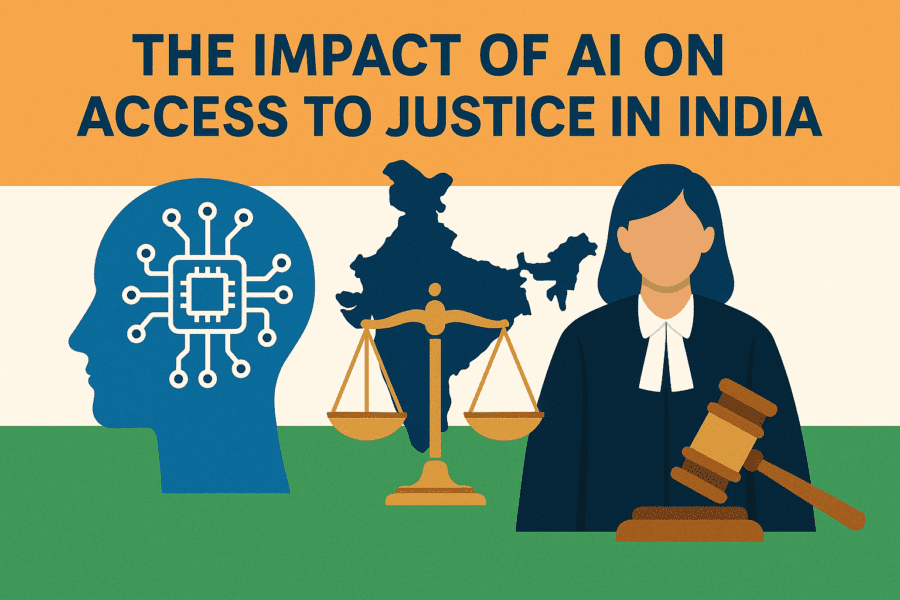Introduction
India’s judiciary faces an overwhelming backlog of cases, delayed justice, and unequal access to legal services. These problems are exacerbated by a shortage of judges and high legal costs. However, the advent of Artificial Intelligence (AI) has begun to reshape the legal landscape, offering innovative solutions to improve access to justice. AI-driven legal technologies are enhancing the efficiency of legal processes, providing affordable legal assistance, and helping bridge the urban-rural justice divide.
1. How AI Elevates Legal Services
AI has the potential to revolutionize the delivery of legal services in India in several key ways:
- Speeding up Legal Research: AI-powered tools can analyze legal documents, identify relevant case laws, and provide accurate legal information in a fraction of the time required by human lawyers. This reduces costs and improves access to information for lawyers and clients alike.
- Efficient Case Management: AI can automate administrative tasks such as scheduling, document filing, and case tracking, reducing the burden on court staff and minimizing delays.
- Automated Documentation: AI tools can assist in drafting legal documents, including contracts, notices, and petitions, helping lawyers and litigants save time and effort.
- Bridging the Geographic Divide: AI-driven mobile apps and online platforms can offer legal advice and information to individuals in remote and underserved areas, bringing justice closer to those who need it most.
- Virtual Legal Assistance: Chatbots and AI legal advisors can provide basic legal guidance and answer common legal queries, making legal support accessible even to those with limited financial resources.
2. The Supreme Court’s Tech-Driven Push
Recognizing the transformative potential of AI, the Supreme Court of India has taken proactive steps to modernize the judiciary through technology:
- E-Courts Initiative: The e-Courts Mission Mode Project aims to digitize court records, enable e-filing, and provide online case status updates. Thousands of courts across India have been integrated into this digital network.
- Virtual Hearings: The COVID-19 pandemic accelerated the adoption of virtual court hearings, allowing parties to participate in legal proceedings remotely, reducing costs and improving accessibility.
- Legal Chatbots and E-Seva Kendras: The judiciary is experimenting with AI chatbots that provide legal information to the public. Additionally, E-Seva Kendras have been set up in courts to assist people in accessing online legal services.
3. Challenges and Ethical Concerns
While AI offers immense potential, its implementation in the legal sector comes with challenges:
- Privacy and Ethics: Legal data is sensitive, and AI tools must adhere to strict privacy standards to avoid data misuse and discrimination. Transparency and accountability in AI decision-making are crucial.
- Limited Digitization: Many Indian courts still rely on physical records, limiting the effectiveness of AI applications. Comprehensive digitization is essential for AI to reach its full potential.
- Regulatory Framework: There is currently no specific legal framework governing the use of AI in the judiciary. Clear guidelines and policies are needed to ensure responsible use.
- Digital Divide: Access to AI-based legal services requires digital literacy and internet access, which many rural populations lack. Bridging this digital divide is crucial for equitable justice.
4. Tele-Law and Legal Aid Initiatives
To complement technological advancements, the Government of India has launched several programs to improve access to justice:
- Tele-Law Scheme: Launched in 2017, this initiative connects marginalized communities with legal aid providers through video conferencing, enhancing access to justice in rural areas.
- National Legal Services Authority (NALSA): NALSA provides free legal services to the underprivileged and works towards spreading legal awareness, playing a key role in ensuring justice for all.
Conclusion
AI holds significant promise in transforming the Indian legal system by improving efficiency, accessibility, and affordability. While challenges such as privacy, ethics, and the digital divide remain, careful implementation, strong regulations, and continued investment in digital infrastructure can help India harness AI’s full potential. With these efforts, the dream of timely and equitable justice for all can move closer to reality.
Contributed by: Vanshika Dhiman (Intern)

